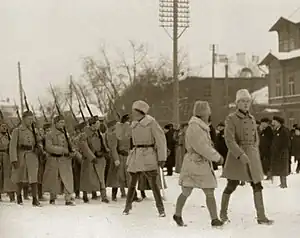| Heimosodat | |||||
|---|---|---|---|---|---|
| Part of the Russian Civil War | |||||
 Finnish volunteers arrive in Tallinn, Estonia in December 1918 during the Estonian War of Independence | |||||
| |||||
| Belligerents | |||||
| Commanders and leaders | |||||
|
| |||||
| Strength | |||||
|
Finland: ~10,000 |
Red Army: 113,000 Red Guard: 1,500 | ||||
The Finnish term Heimosodat (singular heimosota)[lower-alpha 1][1] refers to a series of armed conflicts and private military expeditions in 1918–1922 into areas of the former Russian Empire that bordered on Finland and were inhabited in large part by other Finnic peoples. The term has been translated into English as "Kindred Nations Wars", "Wars for kindred peoples", "Kinfolk wars",[2] or "Kinship Wars," specifically referring to Finnic kinship. Finnish volunteers took part in these conflicts, either to assert Finnish control over areas inhabited by related Finnic peoples, or to help them gain independence from Soviet Russia. Many of the volunteers were inspired by the idea of "Greater Finland". Some of the conflicts were incursions from Finland, and some were local uprisings in which volunteers wanted either to help people fight for independence or to annex areas to Finland. According to Aapo Roselius, about 10,000 volunteers from Finland took part in the armed conflicts mentioned below.[3]
- Estonian War of Independence (1918–1920)
- Pohjan Pojat (lit. 'Sons of the North') and 1st Finnish Volunteer Corps (I Suomalainen Vapaajoukko) helped Estonian troops.
- Viena expedition (1918)
- Aunus expedition (1919)
- Petsamo expeditions (1918 and 1920)
- Revolt of the Ingrian Finns (1918–1920)
- East Karelian Uprising (1921–1922)
The phenomenon is closely linked to nationalism and irredentism, as Finland had just formally gained its national independence in 1917, and a part of the population felt that they had obligations to help other Finnic peoples to attain the same. Estonia, the closest and numerically largest "kindred nation", had gained its independence at the same time, but had fewer resources, fewer institutions ready to support its attained position, and more Bolshevik Russian troops within its borders. Other Finnic peoples were at a less organized level of cultural, economic and political capability. The Finnish Civil War had awakened strong nationalistic feelings in Finnish citizens and other Finnic peoples, and they sought tangible ways to put these feelings into action. For the two next decades, Finns participated at a relatively high rate in nationalistic activities (e.g. Karelianism and Finnicization of the country and its institutions). This development was related to the trauma and divisiveness of the Finnish Civil War. Many White sympathizers in the Civil War became radically nationalistic as a result of the war. The strenuous five-year period 1939–45 of total war — which also mostly unified the nation — reduced this enthusiasm.
Glossary

- Sota
- "War", in this context, a low-intensity one, consisting of actions such as border skirmishes, expeditions by volunteer corps, expulsion of remnant occupational forces or attempts to foment rebellion in the local populace.
- Heimo
- "Tribe" or "clan", but in this context, also the ethnic and language kinship between Baltic Finns; "kindred peoples". Somewhat comparable to the German concept of Völkisch.
- Sukukansa
- People who are linguistically and/or ethnically akin to one another; "suku" means "family" and "kansa" means "people" (singular).
See also
Notes
References
- ↑ Zägel, Jörg; Steinweg, Reiner (2007). Vergangenheitsdiskurse in der Ostseeregion [Discourses on the past in the Baltic Sea region] (in German). LIT Verlag Berlin-Hamburg-Münster. ISBN 978-3-8258-0202-8 – via Google Books.
- ↑ Roselius, Aapo; Silvennoinen, Oula (May 15, 2019). Villi itä: Suomen heimosodat ja Itä-Euroopan murros 1918-1921 [Wild East: Finnish tribal wars and the transition of Eastern Europe 1918-1921] (in Finnish). Tammi. ISBN 9789513175498 – via researchportal.helsinki.fi.
- ↑ Roselius, Aapo (2014). Finnish Irredentist Campaigns in the Aftermath of the Civil War // The Finnish Civil War 1918. History, Memory, Legacy. The Netherlands: Brill. p. 119. ISBN 978-90-04-24366-8 – via Google Books.